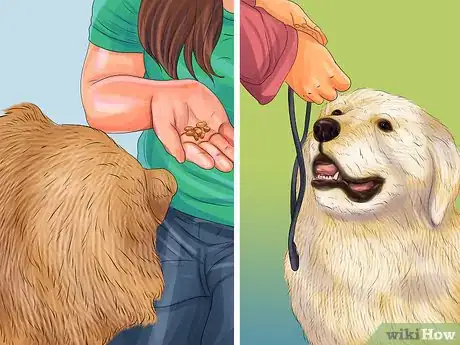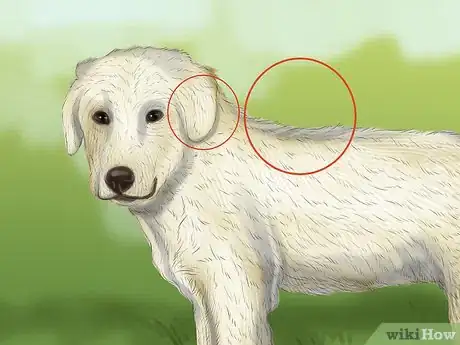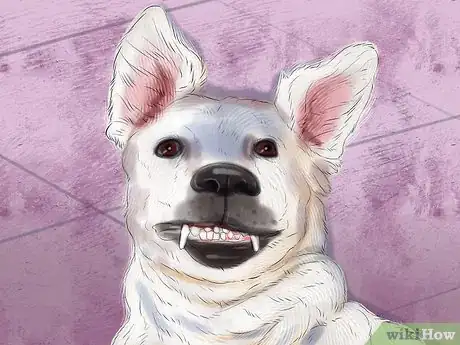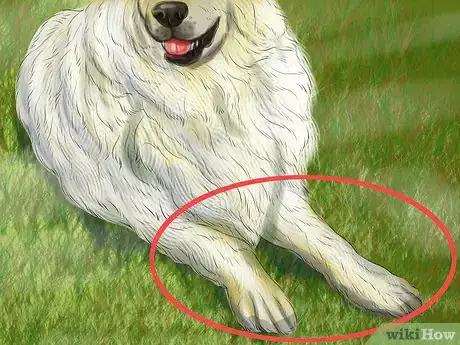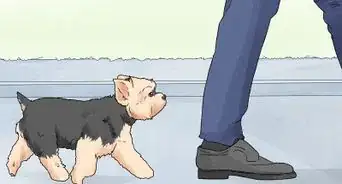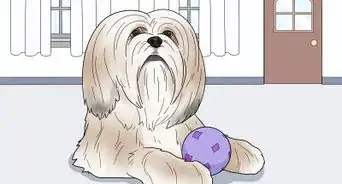This article was co-authored by Corinna Bhasin. Corinna Bhasin is a Dog Behavior & Training Expert, as well as the Owner of LovePup Training and Care LLC. She specializes in reward-based dog training that is customized to each dog’s personality and needs. She’s a Certified Dog Trainer (CDT) and holds a Master’s Degree from Johnson and Wales University and a Bachelor’s Degree from Nanyang Technological University in Singapore.
There are 13 references cited in this article, which can be found at the bottom of the page.
This article has been viewed 33,043 times.
Maremma sheepdogs are white or cream-colored dogs traditionally used to protect and herd sheep. The easiest way to identify one is to check its fur and size. If it is white with thick fur across most of its body, but thin fur on its legs, it could be a Maremma. You could also compare your dog against the average Maremma height and weight to identify it. If you’re still unsure whether or not you’ve got a Maremma sheepdog, monitor the dog’s behavior and look for attentiveness and an overall docile demeanor.
Steps
Noting General Characteristics
-
1Look at the fur. The Maremma sheepdog has white or cream colored fur. Shades of orange or yellow might also be present. If your dog has brown, black, or spotted fur, however, it is not a Maremma.[1]
- The Maremma’s coat should be long and plentiful. It might feel rough to the touch. It should be a bit wavy but not curly.[2]
- The fur on the muzzle, head, ears, and feet will be shorter than on the rest of the body. On limbs, likewise, the hair will be relatively short on the front side, but will be a bit longer on the back side.
- The Maremma sheepdog’s billowing fur makes it poorly adapted to heat.[3]
-
2Weigh the dog. The Maremma sheepdog typically weighs between 70 and 100 pounds. If your dog weighs less than 70 pounds, it might not be a Maremma sheepdog, or it might just be a puppy.[4]
- Bitches average 66 to 88 pounds.[5]
- Male dogs average 77 to 99 pounds.
Advertisement -
3Measure the dog’s height. Maremma sheepdogs stand 25 to 30 inches tall. Of course, it’s possible that you have a jumbo Maremma, in which case it might stand 31 or even 32 inches tall. But if your dog is significantly taller or shorter than the 25 to 30-inch range, it is likely not a Maremma.[6]
-
4Look at the tail. A Maremma’s tail is set low and droops to below the joint of the hock (that is, the point of reverse articulation in the hind legs). When the dog is quiet, the tail will hang dow. If the dog is excited or alert, it will point straight out, its tip curved upward slightly. The tail will be covered with hair just like the rest of the animal.[7]
-
5Observe the build of the dog. Maremma sheepdogs have a supple and sturdy build. The body should be muscular and well-developed. The shoulders should be broad and straight. The body should rise slightly toward the loins before falling toward a strong rump.[8]
- The body should be a bit longer than the dog’s height as measured from the ground to the dog’s shoulder.
-
6Observe the dog’s behavior. Maremma sheepdogs are brave but not aggressive unless provoked.[9] They demonstrate intelligence, and so can easily learn tricks and commands. Overall, they are a lively and hardy breed with an air of majesty about them.[10]
- If the Maremma does not have a flock to guard, they will gradually become more possessive of their owners, more defensive of their possessions (toys, beds, and so on), and more territorial.[11]
- Maremma sheepdogs are aware of their surroundings, but to the untrained eye, their natural attentiveness might be mistaken for nervousness.
- Generally the Maremma is docile, as they are bred to be so.[12]
- Maremmas need space to run and play.
- Maremmas can also be independent thinkers since they have a working breed lineage.
Looking at the Head
-
1Check the eyes. Maremma sheepdogs have bold eyes situated in an almond-shaped aperture. The eye-rims are black and the eyes are dark in color. The eyes are neither too large nor too small. The zone beneath the eyes is gently chiseled.[13]
-
2Look at the head and skull. When a Maremma sheepdog is viewed from the front, the head should assume a triangular shape, and be proportional relative to the body. It should be neither too large nor too small. It should be rounded, with the occipital ridge (the ridge that encloses the back of the skull) slightly raised.[14]
- The muzzle should not be longer than the length of the skull.
- The ears atop the head should be floppy, small, and triangular.[15]
- The neck should be strong, and of medium length.
-
3Check the mouth. The dog’s mouth should contain white teeth. The teeth should be strong and spaced at regular intervals in two even rows. The upper incisors should close neatly over the lower incisors.[16]
Checking Legs and Movements
-
1Look at the forequarters. The forequarters include the front legs and chest. The shoulders should be sloping and well-muscled. The forelegs should be muscular and well-boned without appearing heavy. The pasterns (the sloping part of the dog’s foot between the leg and edge of the toes) should have a low angle when viewed in profile.[17]
-
2Look at the hindquarters. The hindquarters include the rear legs and rump. The rear legs should be muscular and strong. The legs should be equal in length and appear straight when viewed from behind. The hock (the joint from which the rear legs reverse articulate) should have a moderate bend in it.[18]
-
3Observe the dog’s movements. When the Maremma moves, it does so without hesitation. The standard Maremma gait is an extended trot. Maremmas are nimble and can turn quickly.[19]
Expert Q&A
-
QuestionAre Maremma Sheepdogs good pets?
 Pippa Elliott, MRCVSDr. Elliott, BVMS, MRCVS is a veterinarian with over 30 years of experience in veterinary surgery and companion animal practice. She graduated from the University of Glasgow in 1987 with a degree in veterinary medicine and surgery. She has worked at the same animal clinic in her hometown for over 20 years.
Pippa Elliott, MRCVSDr. Elliott, BVMS, MRCVS is a veterinarian with over 30 years of experience in veterinary surgery and companion animal practice. She graduated from the University of Glasgow in 1987 with a degree in veterinary medicine and surgery. She has worked at the same animal clinic in her hometown for over 20 years.
Veterinarian The Maremma Sheepdog Club of America specifically advises against Maremmas being kept as pets. Their protective and guarding nature means they are ever on alert for the ring of a doorbell, and the dog is liable to chase visitors away in order to protect his patch.
The Maremma Sheepdog Club of America specifically advises against Maremmas being kept as pets. Their protective and guarding nature means they are ever on alert for the ring of a doorbell, and the dog is liable to chase visitors away in order to protect his patch. -
QuestionHow long do Maremma Sheepdogs live?
 Pippa Elliott, MRCVSDr. Elliott, BVMS, MRCVS is a veterinarian with over 30 years of experience in veterinary surgery and companion animal practice. She graduated from the University of Glasgow in 1987 with a degree in veterinary medicine and surgery. She has worked at the same animal clinic in her hometown for over 20 years.
Pippa Elliott, MRCVSDr. Elliott, BVMS, MRCVS is a veterinarian with over 30 years of experience in veterinary surgery and companion animal practice. She graduated from the University of Glasgow in 1987 with a degree in veterinary medicine and surgery. She has worked at the same animal clinic in her hometown for over 20 years.
Veterinarian The average life expectancy of a Maremma Sheepdog is about 11 to 13 years.
The average life expectancy of a Maremma Sheepdog is about 11 to 13 years.
Expert Interview

Thanks for reading our article! If you'd like to learn more about dog breed identification, check out our in-depth interview with Corinna Bhasin.
References
- ↑ http://www.maremmaclub.com/maremma-sheepdogs.html
- ↑ http://www.maremmaclub.com/standard.html
- ↑ http://www.terrificpets.com/dog_breeds/Maremma_Sheepdog.asp
- ↑ http://www.maremmaclub.com/maremma-sheepdogs.html
- ↑ http://www.maremmaclub.com/standard.html
- ↑ http://www.maremmaclub.com/maremma-sheepdogs.html
- ↑ http://www.maremmaclub.com/standard.html
- ↑ http://www.maremmaclub.com/standard.html
- ↑ http://www.terrificpets.com/dog_breeds/Maremma_Sheepdog.asp
- ↑ http://www.maremmaclub.com/standard.html
- ↑ http://www.maremmaclub.com/maremma-sheepdogs.html
- ↑ http://thebark.com/content/maremma-sheepdogs-keep-watch-over-little-penguins
- ↑ http://www.maremmaclub.com/standard.html
- ↑ http://www.maremmaclub.com/standard.html
- ↑ http://thebark.com/content/maremma-sheepdogs-keep-watch-over-little-penguins
- ↑ http://www.maremmaclub.com/standard.html
- ↑ http://www.maremmaclub.com/standard.html
- ↑ http://www.maremmaclub.com/standard.html
- ↑ http://www.maremmaclub.com/standard.html





